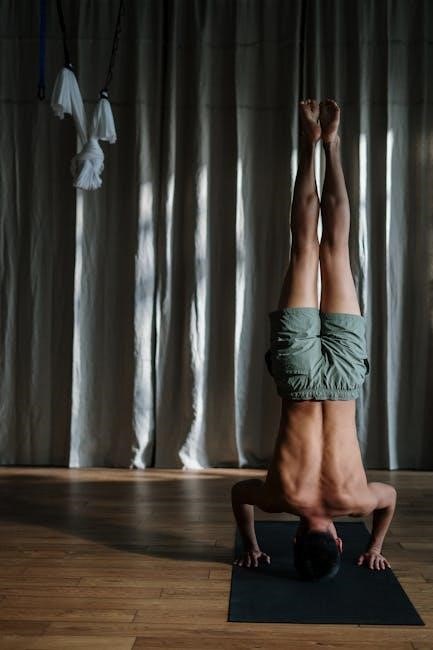
pediatric core strengthening exercises pdf
Pediatric core strengthening is essential for children’s physical development, improving balance, posture, and overall motor skills. It lays the foundation for lifelong physical stability and coordination, while also enhancing focus and academic performance. Simple exercises like tummy time, planks, and animal walks can be incorporated into daily routines. Resources such as PDF guides provide comprehensive exercises tailored for kids, ensuring safe and effective core development.
Importance of Core Strength in Children
Importance of Core Strength in Children
Core strength is crucial for children’s physical and developmental growth. It enhances postural stability, balance, and overall motor skills, reducing the risk of injuries. A strong core improves coordination, which is vital for sports and daily activities. Additionally, it supports fine motor skills, aiding in tasks like writing and using utensils. Strengthening the core also boosts attention and focus, benefiting academic performance. Investing in core exercises early fosters lifelong physical stability and confidence, making it a cornerstone of pediatric development.
Overview of Pediatric Core Strengthening Exercises
Pediatric core strengthening exercises are designed to enhance a child’s stability, balance, and overall physical coordination. These exercises include foundational activities like tummy time, modified planks, and dynamic movements such as animal walks and inch worms. They are structured to be age-appropriate, engaging, and adaptable to different developmental stages. Many exercises are play-based, making them enjoyable for children while effectively targeting core muscles. Resources like PDF guides provide detailed instructions, ensuring parents and educators can safely and effectively implement these exercises.

Understanding Core Strength in Children
Core strength in children refers to the stability and control of the trunk, including abdominal and back muscles. It is crucial for posture, movement, and balance.
Definition and Role of Core Muscles in Kids
The core muscles in children include the abdominals, back, and pelvic muscles, essential for stability and movement. They support posture, balance, and coordination, enabling activities like running and playing. Strong core muscles also improve fine motor skills and overall physical development. Exercises like tummy time and planks help strengthen these muscles, promoting better control and endurance in daily activities. A strong core is foundational for a child’s active and healthy lifestyle.
How Core Strength Impacts Overall Development
Core strength significantly influences a child’s overall development by enhancing physical stability, posture, and balance. It supports proper spinal alignment and reduces the risk of injuries during play or sports. Strong core muscles also improve fine motor skills, essential for tasks like writing and using utensils. Additionally, core strength boosts attention and focus in academic settings, leading to better performance in school. It fosters confidence and encourages active participation in physical activities, promoting a healthy and well-rounded childhood.

Benefits of Core Strengthening Exercises for Children
Core strengthening exercises improve posture, balance, and motor skills in children. They enhance focus and attention, boosting academic performance. Regular practice also reduces injury risks and promotes overall physical confidence.
Improved Postural Stability and Balance
Core strengthening exercises significantly enhance postural stability and balance in children. Strong core muscles provide the foundation for maintaining proper posture, reducing the risk of spinal misalignment. Improved balance enables kids to perform daily activities and sports with greater confidence and coordination. Simple exercises like planks and animal walks target these muscles, while dynamic movements such as inch worms further refine balance and stability. Better posture also contributes to reduced fatigue and fewer accidental injuries, fostering overall physical confidence and independence in children.
Enhanced Fine Motor Skills and Coordination
Strengthening the core muscles in children directly enhances fine motor skills and coordination. A strong core provides stability, enabling precise movements of the hands and fingers. Activities like tummy time and crawling exercises promote better hand-eye coordination and dexterity. Improved coordination also benefits physical activities, such as sports, and academic tasks, like writing. By engaging in core-strengthening exercises, children develop the foundational strength needed for refined movements, fostering independence in daily tasks and enhancing overall developmental progress. Consistent practice ensures lasting improvements in motor function and coordination abilities.
Boosted Attention and Focus in School
Core strengthening exercises significantly improve attention and focus in children, benefiting their academic performance. Strong core muscles enhance posture, reducing physical distractions and allowing better concentration during lessons. Activities like planks and dynamic movements promote neural connections that support cognitive function. Regular engagement in core exercises fosters self-discipline and mental clarity, essential for school success. By incorporating these exercises into daily routines, children develop the physical and mental stamina needed to stay focused and perform well academically.

Key Core Muscles in Children
The core includes abdominal, back, and pelvic muscles, essential for stability and movement. Strengthening these muscles supports posture, balance, and overall physical development in children.
Abdominal Muscles and Their Function
Abdominal muscles play a crucial role in core stability, posture, and movement. They include the rectus abdominis, obliques, and transverse abdominis. These muscles support the spine, aid in bending, and help with breathing; Strengthening them through exercises like tummy time, planks, and inch worms improves posture and reduces the risk of injuries. Weak abdominal muscles can lead to poor posture and developmental delays, making targeted exercises essential for children’s overall physical development and motor skill enhancement.
Back and Pelvic Muscles in Core Stability
The back and pelvic muscles are vital for core stability, working alongside abdominal muscles to support the spine and maintain proper posture. These muscles, including the latissimus dorsi and erector spinae, help stabilize the trunk during movement. Weakness in this area can lead to poor posture and increased injury risk. Strengthening exercises like Superman, bird-dog, and pelvic tilts target these muscles, enhancing overall core stability and improving coordination. Strong back and pelvic muscles also contribute to better balance and athletic performance in children.

Developmental Considerations
Core strengthening exercises must be tailored to a child’s developmental stage, ensuring activities are age-appropriate and adaptable for those with delays. Monitoring progress and adjusting exercises as needed supports optimal growth and skill development.
Age-Appropriate Exercises for Different Stages
Exercises for infants often begin with tummy time to strengthen neck and back muscles. Toddlers benefit from modified planks and crawling activities. School-age children can engage in dynamic movements like inch worms and animal walks. For adolescents, core-strengthening exercises may include bridges or dynamic planks. Each stage requires exercises tailored to the child’s developmental abilities, ensuring safety and effectiveness. Adapting exercises to meet individual needs promotes proper growth and motor skill development. Free PDF guides offer detailed age-specific routines.
Adapting Exercises for Children with Developmental Delays
For children with developmental delays, core exercises must be tailored to their individual needs. Techniques include breaking exercises into smaller steps, using supportive devices, and incorporating sensory integration strategies. Activities like modified tummy time or seated planks can help build strength gradually. Visual or tactile cues may enhance participation. Collaboration with occupational therapists ensures exercises are adapted appropriately. Progress should be monitored closely, with adjustments made to maintain engagement and effectiveness. PDF guides often provide adaptable routines to accommodate diverse developmental requirements.

Effective Core Strengthening Exercises for Kids
Exercises like tummy time, planks, animal walks, and inch worms are effective for building core strength in children, promoting stability, coordination, and overall physical development.
Tummy Time: A Foundation for Core Strength
Tummy time is a fundamental exercise for infants and young children, helping build core strength. By lying on their stomachs, kids engage abdominal muscles, improve neck strength, and enhance posture. Starting with short sessions and gradually increasing duration is key. Parents can make it engaging with toys or mirrors. This simple activity lays the groundwork for crawling, sitting, and overall motor development, making it a crucial part of pediatric core strengthening routines.
Plank Exercises Modified for Children
Modified plank exercises are an excellent way to build core strength in children. Start with a modified plank on knees instead of toes to make it age-appropriate. Guide the child to maintain a straight line from head to heels and engage their core muscles. Hold for a few seconds and gradually increase the duration as strength improves. These exercises help improve posture, balance, and overall stability. They can be incorporated into playtime or as part of a structured routine, making them fun and effective for kids.
Animal Walks and Crawling Exercises
Animal walks and crawling exercises are engaging and effective for building core strength in children. Activities like bear crawls, crab walks, and leopard crawls work multiple muscle groups while promoting coordination. These exercises encourage proper posture and engage the abdominal muscles, back, and legs. Start with short distances and gradually increase as the child gains strength. Incorporating these into playtime, such as racing or obstacle courses, makes them fun and motivating. They also improve overall physical stability and posture, preparing children for more complex movements in sports and daily activities.
Inch Worms and Other Dynamic Movements
Inch worms and dynamic movements are excellent for core strengthening in children. These exercises involve bending, stretching, and moving, which engage the abdominal muscles, back, and pelvis. Inch worms, for example, require bending at the waist and walking hands forward, promoting flexibility and strength. Other movements like arm swings, leg lifts, and torso twists further enhance coordination and balance. These exercises are adaptable to different ages and abilities, making them ideal for developing core stability and overall physical fitness in a fun and engaging way.

Incorporating Core Exercises into Daily Routine
Incorporating core exercises into daily routines can be achieved through playtime activities and school programs. Animal walks, crawling, and dynamic movements like inch worms make it fun and engaging, enhancing strength, balance, and coordination in children.
Integrating Exercises into Playtime
Integrating core exercises into playtime is an effective way to promote strength and coordination in children. Activities like animal walks, crawling, and inch worms can be incorporated into games, making exercise fun. Balance challenges, such as standing on one foot or using a balance beam, also enhance core stability. Parents can turn these exercises into interactive games, ensuring kids enjoy the process while building strong core muscles. Simple, equipment-free activities make it easy to weave core strengthening into daily play, fostering physical development and overall well-being.
Core Strengthening Activities in School Settings
Schools play a vital role in promoting core strengthening through structured activities. Classroom-based exercises, such as seated marching or desk push-ups, can be easily incorporated. Animal walks and crawling during physical education classes enhance coordination and balance. Teachers can integrate short core-strengthening breaks between lessons to improve focus and energy levels. Additionally, group activities like partner planks or balance challenges foster teamwork while building core muscles. These exercises not only support physical development but also improve attention and participation in academic settings. PDF guides offer educators creative and age-appropriate ideas for implementation.

Role of Parents and Educators
Parents and educators collaborate to promote core strengthening by creating supportive environments and providing resources. They encourage daily exercises and activities that foster physical and cognitive growth.
Guidance for Parents in Promoting Core Strength
Parents play a vital role in fostering core strength in children by encouraging daily activities and creating a supportive environment. They can integrate exercises like tummy time, animal walks, and planks into playtime, making them fun and engaging. Providing positive reinforcement and consistency helps build a strong foundation for physical development. Parents should also consult pediatricians or therapists for personalized advice. By prioritizing core-strengthening activities, parents contribute to their child’s improved posture, balance, and overall well-being, setting them up for lifelong physical and cognitive benefits.
Strategies for Educators to Encourage Core Exercises
Educators can incorporate core-strengthening activities into school routines to promote physical and cognitive development. Integrate exercises like animal walks or inch worms during recess or physical education classes. Encourage classroom brainstorming sessions to create fun, child-led core activities. Consistency is key; short, regular exercises can yield significant benefits. Collaborate with parents by sharing PDF guides or exercise ideas for home practice. By fostering a supportive environment, educators help children build core strength, improving posture, balance, and focus, ultimately enhancing their academic performance and overall well-being.

Safety and Guidelines
Ensure children perform exercises with proper technique to avoid injury. Supervise activities and adjust intensity based on age and ability. Monitor progress and adapt exercises as needed for safety and effectiveness.
Proper Technique to Avoid Injury
Ensuring proper technique is crucial to prevent injuries during pediatric core strengthening exercises. Children should maintain correct posture and alignment, avoiding excessive strain on joints or muscles. Supervision by parents or educators is essential to guide proper form and address any potential risks. Exercises should be modified according to the child’s developmental stage and ability. For example, planks can be performed on knees instead of toes for younger children. Encouraging slow, controlled movements helps build strength safely and effectively, promoting long-term physical stability and coordination.
Monitoring Progress and Adjusting Exercises
Regularly monitoring a child’s progress in core strengthening exercises ensures safety and effectiveness. Parents and educators should observe improvements in posture, balance, and overall physical stability. Exercises should be adjusted based on the child’s age, ability, and developmental stage. For example, younger children may start with shorter planks, gradually increasing duration as strength improves. Tracking progress helps identify areas needing more focus, allowing for tailored adjustments to maximize benefits while minimizing the risk of injury or frustration.

Resources and References
Downloadable PDF guides offer comprehensive pediatric core exercises, including tummy time and animal walks. Additional materials provide detailed instructions for parents and educators to promote development.
Recommended PDF Guides for Pediatric Core Exercises
Various PDF guides provide comprehensive routines for pediatric core strengthening, featuring exercises like tummy time, inch worms, and animal walks. These resources are designed for parents and educators, offering step-by-step instructions and visual aids to ensure proper technique. They cater to different developmental stages, including children with delays, and emphasize safety and progression. Many guides are free to download, making them accessible tools for promoting strong core development in kids. They also include tips for integrating exercises into daily play and school activities effectively.
Additional Materials for Comprehensive Development
Beyond PDF guides, additional materials like videos, interactive apps, and activity charts enhance pediatric core strengthening. These resources offer visual demonstrations and engaging methods to keep children motivated. Video tutorials provide step-by-step instructions for exercises such as inch worms and animal walks. Apps incorporate games that promote core engagement while maintaining fun. Progress-tracking charts help monitor development and celebrate milestones. These tools complement PDF guides, creating a well-rounded approach to improving core strength and overall physical development in children.